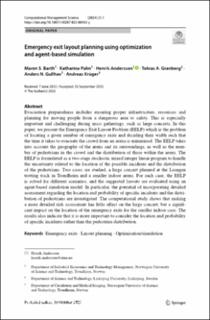| dc.contributor.author | Barth, Maren Schliekelmann | |
| dc.contributor.author | Palm, Katharina | |
| dc.contributor.author | Andersson, Carl Henrik | |
| dc.contributor.author | Granberg, Tobias Andersson | |
| dc.contributor.author | Gullhav, Anders Nordby | |
| dc.contributor.author | Krüger, Andreas Jørstad | |
| dc.date.accessioned | 2024-03-11T10:20:29Z | |
| dc.date.available | 2024-03-11T10:20:29Z | |
| dc.date.created | 2023-11-06T12:53:31Z | |
| dc.date.issued | 2023 | |
| dc.identifier.issn | 1619-697X | |
| dc.identifier.uri | https://hdl.handle.net/11250/3121765 | |
| dc.description.abstract | Evacuation preparedness includes ensuring proper infrastructure, resources and planning for moving people from a dangerous area to safety. This is especially important and challenging during mass gatherings, such as large concerts. In this paper, we present the Emergency Exit Layout Problem (EELP) which is the problem of locating a given number of emergency exits and deciding their width such that the time it takes to evacuate the crowd from an arena is minimized. The EELP takes into account the geography of the arena and its surroundings, as well as the number of pedestrians in the crowd and the distribution of these within the arena. The EELP is formulated as a two-stage stochastic mixed integer linear program to handle the uncertainty related to the location of the possible incidents and the distribution of the pedestrians. Two cases are studied, a large concert planned at the Leangen trotting track in Trondheim and a smaller indoor arena. For each case, the EELP is solved for different scenarios, and the suggested layouts are evaluated using an agent-based simulation model. In particular, the potential of incorporating detailed assessment regarding the location and probability of specific incidents and the distribution of pedestrians are investigated. The computational study shows that making a more detailed risk assessment has little effect on the large concert, but a significant impact on the location of the emergency exits for the smaller indoor case. The results also indicate that it is more important to consider the location and probability of specific incidents rather than the pedestrian distribution. | en_US |
| dc.language.iso | eng | en_US |
| dc.publisher | Springer Nature Ltd. | en_US |
| dc.rights | Navngivelse 4.0 Internasjonal | * |
| dc.rights.uri | http://creativecommons.org/licenses/by/4.0/deed.no | * |
| dc.title | Emergency exit layout planning using optimization and agent-based simulation | en_US |
| dc.title.alternative | Emergency exit layout planning using optimization and agent-based simulation | en_US |
| dc.type | Peer reviewed | en_US |
| dc.type | Journal article | en_US |
| dc.description.version | publishedVersion | en_US |
| dc.source.volume | 21 | en_US |
| dc.source.journal | Computational Management Science | en_US |
| dc.source.issue | 1 | en_US |
| dc.identifier.doi | 10.1007/s10287-023-00482-y | |
| dc.identifier.cristin | 2192613 | |
| cristin.ispublished | true | |
| cristin.fulltext | original | |
| cristin.qualitycode | 1 | |

